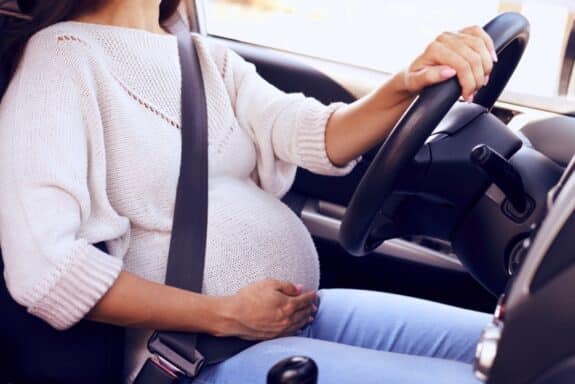When pregnant, we ladies worry about an awful lot of things. From how we’re going to decorate the nursery to what outfit you’re bringing baby home in. But a new research study shows that perhaps we should keep an eye on that pesky “pregnancy brain,” and how it affects our driving. The study suggests that women who are pregnant have more car accidents than in the years before or after pregnancy.
The study, published in the Canadian Medical Association Journal, found that pregnant women are more susceptible to vehicular accidents during the second trimester, a time, according to the study, that women begin to feel many of the effects of their pregnancy, and they may not drive as safely as they would with a late-term pregnancy belly. One of the authors involved in the study attributes the increase in accidents to the cognitive impairment that many women experience during pregnancy, most commonly known as the “pregnancy brain.” Donald Redelmeier, a researcher at the Institute for Clinical Evaluative Sciences in Toronto says “All those changes could contribute to driver error.”
Redelmeier and his colleagues studied the records of more than 500,000 women in Ontario who were pregnant and gave birth. These women were tracked for four years before their pregnancy and one year after their children’s birth. Researchers looked at each car crash that occurred during that time period that was serious enough to send the woman to the emergency room. Before their pregnancies, the amount of these serious vehicle accidents for all of the women who drove was approximately 177 per month, which works out to an annual rate of 4.5 per 1,000. That number did not change during the first month of pregnancy. However, by month four of the pregnancy, the same women were involved in 299 serious vehicle crashes per month, working out to an annual rate of 7.6 per 1,000. By the last month of pregnancy, that rate dropped to 2.7 per 1,000, and continued to stay low during the year following the birth of the women’s children. Redelmeier believes that the rate stayed low because the new mothers likely drove less, or had their newborns in the car with them.
The research did not find any of the same increases in emergency visits for pregnant pedestrians or passengers. Redelmeier says,“We are not saying that pregnant women shouldn’t drive.” He also believes that driving also shouldn’t solely fall on male partners, who tend to have worse accident rates than women. He says that women should just make certain to drive as safely during mid-pregnancy as they do when they are late-term in their pregnancy or with their newborns in their vehicles. He adds, “Just slow down and follow the rules of the road.”
Anthony Vintzileos, the chief of obstetrics and gynecology at Winthrop-University Hospital in New York, says that the study is “robust” and that the “results make sense.” York also believes that some of the more common sleep disorders women experience during pregnancy may play a role in the car accidents. York was not involved in the study. Emergency room physician Sampson Davis at Meadowlands Hospital Medical Center in New Jersey says that the study does not convince him that there is a link between pregnancy symptoms and auto accidents. He believes that the researchers did not take into account all of the possible contributing factors, like the weather when the women were driving, as well as any other medical conditions that the pregnant women may have been affected with. He also believes that it is rather “odd” that the risk of a vehicular accident did not increase with the first trimester, which is when most pregnant women feel the worst. Davis adds “It is important for pregnant drivers to take care. The farther along the pregnancy is, the more the fetus is exposed…There are no bones around the uterus.”
The American College of Obstetricians and Gynecologists do urge pregnant women to be certain that they use seatbelts with a lap and shoulder belt when they are driving, and adds that they should also keep airbags turned on at all times. Experts say that pregnant drivers should keep a minimum of ten inches between the steering wheel and their breastbone. Passengers who are pregnant should move the front seat they are sitting in as far back as possible, or when possible, sit in the back seats, according to the National Highway Traffic Safety Administration.







